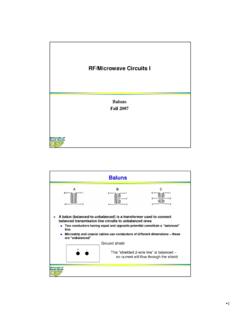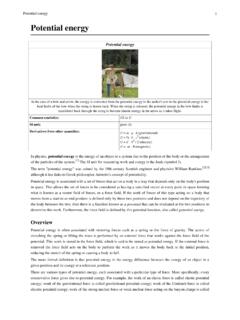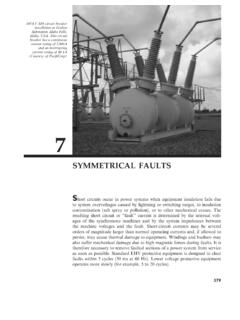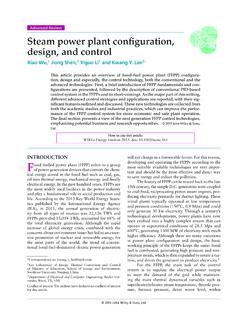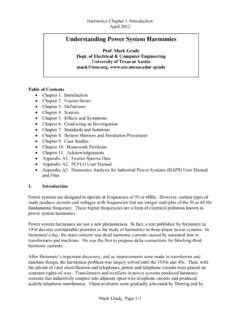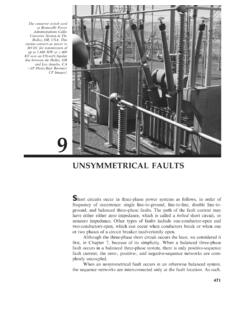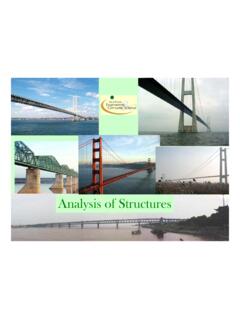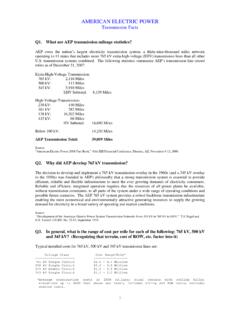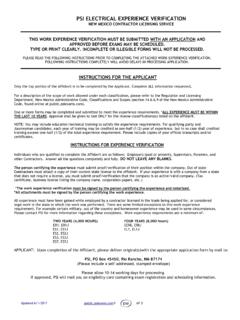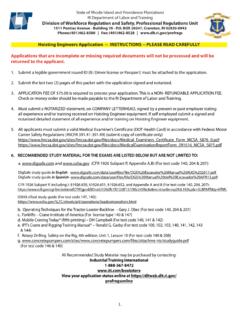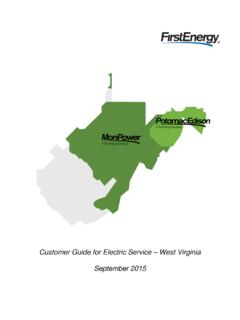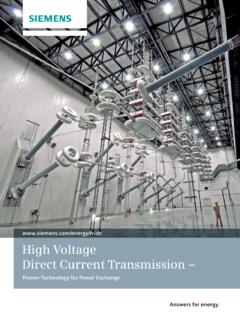Transcription of TRANSMISSION LINE PARAMETERS - Baylor University
1 765-kV TRANSMISSION linewith aluminum guyed-Vtowers (Courtesy ofAmerican Electric PowerCompany)4 TRANSMISSION LINE PARAMETERSIn this chapter, we discuss the four basic TRANSMISSION -line PARAMETERS : seriesresistance, series inductance. shunt capacitance, and shunt conductance. Wealso investigate TRANSMISSION -line electric and magnetic resistance accounts for ohmic I2R line losses. Series impedance,including resistance and inductive reactance, gives rise to series-voltage dropsalong the line. Shunt capacitance gives rise to line-charging currents. Shuntconductance accounts for V2G line losses due to leakage currents betweenconductors or between conductors and ground. Shunt conductance of over-head lines is usually the ideas developed in this chapter can be applied to under-ground TRANSMISSION and distribution, the primary focus here is on overheadlines.
2 underground TRANSMISSION in the United States presently accounts forless than 1% of total TRANSMISSION , and is found mostly in large cities or under159waterways. There is, however, a large application for underground cable indistribution STUDYTwo TRANSMISSION articles are presented here. The first article covers transmissionconductor technologies including conventional conductors, high-temperature conductors,and emerging conductor technologies [10]. Conventional conductors include the aluminumconductor steel reinforced (ACSR), the homogeneous all aluminum alloy conductor(AAAC), the aluminum conductor alloy reinforced (ACAR), and others. High-temperatureconductors are based on aluminum-zirconium alloys that resist the annealing effects of hightemperatures.
3 Emerging conductor designs make use of composite material second article describes trends in TRANSMISSION and distribution line insulators for sixNorth American electric utilities [12]. Insulator technologies include porcelain, toughenedglass, and polymer (also known as composite or non-ceramic). All three technologies arewidely used. Current trends favor polymer insulators for distribution (less than 69 kV)because they are lightweight, easy to handle, and economical. Porcelain remains in wide usefor bulk power TRANSMISSION lines, but maintenance concerns associated with managementand inspection of aging porcelain insulators are driving some utilities to question their cost considerations and ease of inspection for toughened glass insulators aresteering some utilities toward glass Line Conductor DesignComes of AgeART J.
4 PETERSON JR. AND SVEN HOFFMANND eregulation and competition have changed powerflows across TRANSMISSION networks , demand for electricity continues togrow, as do the increasing challenges of buildingnew TRANSMISSION circuits. As a result, utilities needinnovative ways to increase circuit capacities to re-duce congestion and maintain Grid is monitoring TRANSMISSION conduc-tor technologies with the intent of testing and de-ploying innovative conductor technologies within theUnited States over the next few years. In the UK,National Grid has been using conductor replacementas a means of increasing circuit capacity since the mid1980s, most recently involving the high-temperature,low-sag Gap-type conductor. As a first step in de-veloping a global conductor deployment strategy,National Grid embarked on an overall assessment ofoverhead TRANSMISSION line conductor technologies,examining innovative, and emerging National GridNational Grid USA is a subsidiary of National GridTransco, an international energy-delivery businesswith principal activities in the regulated electric andgas industries.
5 National Grid is the largest trans-mission business in the northeast United States, aswell as one of the 10 largest electric utilities in theUnited States National Grid achieved this by com-bining New England Electric System, Eastern UtilitiesAssociates and Niagara Mohawk between March2000 and January 2002. Its electricity-delivery net-work includes 9000 miles (14,484 km) of trans-mission lines and 72,000 miles (115,872 km) ofdistribution Grid UK is the owner, operator anddeveloper of the high-voltage electricity transmis-sion network in England and Wales, comprising ap-proximately 9000 circuit-miles of overhead lineand 600 circuit-miles of underground cable at 275and 400 kV, connecting more than 300 substations.( TRANSMISSION Line Conductor Design Comes of Age by ArtJ.)
6 Peterson Jr. and Sven Hoffmann, TRANSMISSION & DistributionWorld Magazine, (Aug/2006). Reprinted with permission ofPenton Media)160 CHAPTER 4 TRANSMISSION LINE PARAMETERS 9000 circuit-miles 14,500 circuit-km 600 circuit-miles 1000 circuit-kmCONVENTIONAL CONDUCTORSThe reality is that there is no single wonder mate-rial. As such, the vast majority of overhead lineconductors are nonhomogeneous (made up ofmore than one material). Typically, this involves ahigh-strength core material surrounded by a high-conductivity material. The most common conduc-tor type is the aluminum conductor steel reinforced(ACSR), which has been in use for more than 80years. By varying the relative cross-sectional areasof steel and aluminum, the conductor can be madestronger at the expense of conductivity (for areaswith high ice loads, for example), or it can be mademore conductive at the expense of strength whereit s not recently, in the last 15 to 20 years, thehomogeneous all-aluminum alloy conductor (AAAC)has become quite popular, especially for NationalGrid in the UK where it is now the standard con-ductor type employed for new and refurbishedlines.
7 Conductors made up of this alloy (a heattreatable aluminum-magnesium-silicon alloy) are, forthe same diameter as an ACSR, stronger, lighter, andmore conductive although they are a little more ex-pensive and have a higher expansion , their high strength-to-weight ratio allowsthem to be strung to much lower initial sags, whichallows higher operating temperatures. The resultingtension levels are relatively high, which could resultin increased vibration and early fatigue of the con-ductors. In the UK, with favorable terrain, windconditions and dampers, these tensions areacceptable and have allowed National Grid to in-crease the capacities of some lines by up to 50%.For the purpose of this article, the three mate-rials mentioned so far steel, aluminum and alumi-num alloy are considered to be the materialsfrom which conventional conductors are made.
8 TheACSR and AAAC are two examples of such conduc-tors. Other combinations available include alumi-num conductor alloy reinforced (ACAR), aluminumalloy conductor steel reinforced (AACSR) and theless common all-aluminum conductor (AAC).Conductors of these materials also are availablein other forms, such as compacted conductors,where the strands are shaped so as not to leave anyvoids within the conductor s cross section (a stan-dard conductor uses round strands), increasing theamount of conducting material without increasingthe diameter. These conductors are designatedtrapezoidal-wire (TW) or, for example, ACSR/TWand AACSR/TW. Other shaped conductors areavailable that have noncircular cross sections de-signed to minimize the effects of wind-induced mo-tions and CONDUCTORSR esearch in Japan in the 1960s produced a seriesof aluminum-zirconium alloys that resisted the an-nealing effects of high temperatures.
9 These alloys canretain their strength at temperatures up to 230 C(446 F). The most common of these alloys TA1,ZTA1 and XTA1 are the basis of a variety of high-temperature STUDY161De-stranding the Gap conductor for field installationRe-stranding of conductorThe thermal expansion coefficients of all theconventional steel-cored conductors are governedby both materials together, resulting in a value be-tween that of the steel and that of the behavior relies on the fact that both compo-nents are carrying mechanical , because the expansion coefficient ofaluminum is twice that of steel, stress will be in-creasingly transferred to the steel core as the con-ductor s temperature rises. Eventually the corebears all the stress in the conductor.
10 From thispoint on, the conductor as a whole essentially takeson the expansion coefficient of the core. For a typ-ical 54/7 ACSR (54 aluminum strands, 7 steel) thistransition point (also known as the knee-point )occurs around 100 C (212 F).For lines built to accommodate relatively largesags, the T-aluminum conductor, steel reinforced(TACSR) conductor was developed. (This is essen-tially identical to ACSR but uses the heat-resistantaluminum alloy designated TA1). Because this con-ductor can be used at high temperatures with nostrength loss, advantage can be taken of the low-sagbehavior above the a conductor could be designed with a corethat exhibited a lower expansion coefficient thansteel, or that exhibited a lower knee-point temper-ature, more advantage could be taken of the high-temperature alloys.
